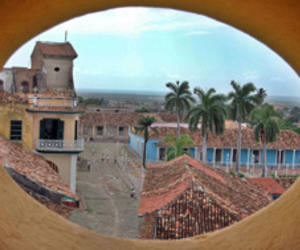Trinidad Village: Created from Honey and Sugar Cane Syrup
- Submitted by: manso
- Travel and Tourism
- 09 / 06 / 2011

2011.09.05 - 11:24:39 / radiorebelde.icrt.cu / Trinidad, Sancti Spíritus, Cuba.- The Santísima Trinidad village was founded during the first days of January of the year 1514, thus dating back some 497 years. Besides, its climate and proximity to the sea as well as the fertility of its lands made of that village a coveted goal and those who settled in it favored, with the beginning of the 18th century, an economic expansion that will leave its mark forever on this site as an architectural jewelry.
The urban architecture, which is well-adapted to the tropical temperature and the shining light of the Caribbean, can be watched in stately homes, parks and churches located near paving streets where it is still possible to see wooden sections, as well as large windows, spacious houses with hallways and balconies which feature the village´s typical constructions.
Many interesting details that are part of the village include the kind population with their go to and fro, the seller of fish, the accent of the local radio station that air a colorful image of the environment, the craftworks of every single morning in the streets, the wreath of flowers that seems to invite the traveler to be protected from the sun in the central park and the view of the Escambray mountain range and its hidden cages.
The first decades of the 19th century represented a great splendor to Trinidad and the booming production of the sugar cane made it even a more prosperous village. However, its arquitecture continued reflecting the former century. There were already 56 sugar refineries with more than 11 thousand 627 slaves in 1827. The houses used to have spacious porches, facades and stained glass windows and grilles which in Trinidad constitute a relevant detail taking into account their size, design and beauty.
Thanks to its former splendor, Trinidad still has at present time one of the more prefect, beautiful and well-preserved arquitecture in Latin America, which has enabled to be recognized as the museum city of Cuba.
The San Luis de los Ingenios valley is located in this village urban center and next to an ancient watchtower that stands as an exponent of the architectural eclecticism on the island. Its ruins and huts where African slave were gathered together, still survive and are considered as heritage of mankind by UNESCO since 1988.
The Casona museum of the Iznaga tower that is linked to the history of then rich landowners Alejo and Pedro Iznaga and their dispute for a young woman, took those brothers to build a work of which its height measured in metres would define the victory. Therefore, Alejo built the watchtower of 45 metres height and Pedro drilled a well of 28 metres deep of which it is said that the settlers of the village still drink from its subterranean waters.
As also happens in those activities held in the Memorial Museum House where lived Major General Vicente García in Las Tunas province, in Trinidad, on its part, is preserved the typical beverage of the war of independence, elaborated from honey, lemon and a local alcoholic drink that was named Canchánchara mambisa.
As a matter of fact, the Santísima Trinidad constitutes a real outdoor museum city that, at least in my case, was difficult to me to fully describe in detail in such brief time. By Juan Manuel Olivares and Translated by: Juan Carlos Caballero Puig.
Comments